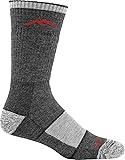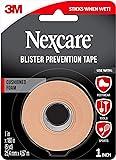So, you’ve got yourself a brand-new pair of hiking boots — congrats! Take it from someone who has hiked way too many miles in new stiff boots, break them in before you hit the trails. Wearing stiff boots hiking can turn an exciting adventure into a painful ordeal with blisters and sore feet. But with a little preparation and patience, you can ensure that your new boots are as comfortable as they are sturdy, making your next hike an enjoyable experience from start to finish.
We don’t want to waste any more of your time but if you have new boots it’s important to wear high quality socks. Darn Tough merino socks are widely regarded as the best of the best. We can’t recommend them highly enough.

Darn Tough Merino Wool Boot Sock Full Cushion Merino Wool: The ultimate fiber for breathability and comfort in all conditions. Performance Fit: No slipping, no bunching, and no blisters; True Seamless: Undetectable seam fusion for an ultra-smooth, invisible feel Guaranteed for Life: If these socks wear, tear, or develop holes, Darn Tough will replace them; No strings; No conditions
Tips On Breaking In Hiking Boots
#1. Start at Home
Wear your boots while doing chores or walking around the house. This low-impact activity still helps break them in without stressing your feet too much. The controlled environment of your home allows you to focus on how the boots feel without the added pressure of rough terrain. Plus, you can easily take breaks if you start to feel any discomfort, giving your feet time to adjust.
#2. Be Patient
Breaking in new boots can take time, so don’t rush the process. Gradually increasing wear time will lead to the best fit and comfort. Trying to force the process can lead to blisters and discomfort, which can set you back even further. Remember, each boot is different, and some may require more time to fully mold to your feet. Patience here will pay off with boots that feel like a natural extension of your feet.
#3. Start Slow with Short Walks
Begin by wearing your new boots around the house or on short walks. This allows your feet to adjust to the fit and the boots to start molding to your feet. Short walks are ideal because they expose your boots to gentle, everyday movements without overwhelming your feet. Over time, the boots will begin to soften, and you’ll start to notice them becoming more comfortable with each outing.
#4. Wear the Right Socks
Use the same socks you plan to hike in. This helps ensure the boots break in with the exact padding and thickness you’ll use on the trail. Different socks can change the fit of your boots, so sticking with your hiking socks during the break-in process is key. Make sure the socks provide the right amount of cushioning and moisture-wicking to keep your feet comfortable and dry.
#5. Alternate with Your Old Boots
Rotate between your new boots and an older, more comfortable pair during the break-in period to avoid over-stressing your feet. This way, you can still enjoy your hikes without putting too much pressure on your feet as they adjust to the new boots. It also gives you the chance to compare how the new boots are coming along and make any necessary adjustments, like trying different lacing techniques or socks.
#6. Use Blister Prevention Products
Consider using blister prevention tapes or anti-friction balms during the break-in period to protect your feet from irritation. These products can be lifesavers, especially in the early stages when your boots might be stiff. Applying them to common problem areas like heels and toes can create a barrier that reduces friction and prevents blisters from forming, allowing you to focus on enjoying your hike.
Note: Read this post on preventing blisters while hiking.

Body Glide Foot Glide Anti Blister Balm | blister prevention for heels, shoes, cleats, boots, socks, and sandals | Use on toes, heel, ankle, arch, sole and ball of foot | 0.8oz

Nexcare Blister Prevention Tape, Waterproof Foam Medical Tape, Sticks Firmly to Skin to Help Prevent Blisters - 1 In x 5 Yds, 1 Roll of Tape
#7. Lace Up Properly
Experiment with different lacing techniques to find the most comfortable and secure fit. Proper lacing can prevent hot spots and blisters. Tightening or loosening specific parts of your boots can make a big difference in how they feel. For instance, a looser fit at the toes and a tighter fit at the ankles can reduce slipping and provide better support, making your hikes more comfortable and reducing the risk of injury.
#8. Gradually Increase Distance and Terrain
After short walks, move on to longer walks on varied terrain. This helps the boots adapt to different conditions while allowing your feet to adjust. Gradually increasing the difficulty of your hikes allows your boots to conform more precisely to the shape of your feet. It also helps you identify any potential issues before they become bigger problems, like pressure points or areas that might need extra padding.
#9. Mind the Weather
Avoid breaking in boots in wet conditions if they aren’t waterproof. Water can make the boots stiffen as they dry, making them harder to break in. Wet boots can also lead to uncomfortable hiking experiences, as moisture can cause your feet to swell, increasing the risk of blisters. Stick to dry conditions initially, and if your boots do get wet, ensure they’re properly dried out before wearing them again to maintain their comfort and flexibility.
In Conclusion
Breaking in new hiking boots might take a bit of time and effort, but trust us—it’s well worth it. By following these tips, you’ll ensure that your boots are not just another piece of gear but an essential part of your outdoor experience. Comfortable boots mean you can focus on the beauty around you, the thrill of the hike, and the joy of the journey, rather than worrying about sore feet.
Remember, the key is patience and gradual progress. Give your feet and your boots the time they need to get to know each other, and soon enough, you’ll have a pair of boots that feel like a natural extension of your body. So lace up, hit the trail, and enjoy every step of your adventure!
We’d love to hear your own tips and experiences with breaking in new boots, so hit us up on social media. If you found this guide helpful, check out our other posts for more gear tips and outdoor inspiration. Happy hiking!
